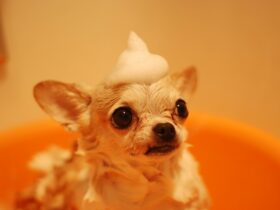Pets bring joy, companionship, and warmth to our lives. However, they can also bring challenges, especially when it comes to accidents on the carpet. Cleaning pet urine from carpets is essential to maintain a fresh and odor-free home. This blog will guide you through the process of effectively cleaning pet urine from carpets, covering both DIY methods and professional tips to ensure your carpets remain clean and fresh.
Understanding the Problem
1. Why Cleaning Pet Urine is Important
- Odor Control: Pet urine can leave a lingering odor that penetrates deep into the carpet fibers, making it difficult to remove.
- Stain Prevention: If not addressed quickly, pet urine can cause permanent staining, especially on light-colored carpets.
- Hygiene: Pet urine can harbor bacteria and germs, which could be harmful to your health.
- Behavioral Concerns: If your pet smells old urine spots, they may continue to use that area, reinforcing bad habits.
2. Why Pet Urine is Challenging to Remove
- Composition of Urine: Pet urine contains uric acid crystals that are difficult to break down. Even after cleaning, the crystals may remain, causing odors to resurface.
- Absorption: Carpets are absorbent, meaning urine can seep deep into the padding and subfloor, making complete removal challenging.
DIY Methods for Cleaning Pet Urine from Carpet
1. Immediate Action is Key
- Blot the Area: Use paper towels or an old cloth to blot up as much urine as possible. Press down firmly to absorb the liquid, but avoid rubbing, as this can spread the urine further into the carpet fibers.
- Use Cold Water: Pour a small amount of cold water over the area to dilute the urine. Blot again to absorb the moisture.
2. Use Vinegar and Baking Soda
- Create a Solution: Mix equal parts white vinegar and water in a spray bottle. Vinegar neutralizes the ammonia in urine, reducing odors.
- Apply the Solution: Spray the vinegar solution onto the urine spot, ensuring the area is fully saturated.
- Blot the Area Again: After allowing the solution to sit for a few minutes, blot the area with a clean cloth.
- Apply Baking Soda: Sprinkle a generous amount of baking soda over the treated area. Baking soda absorbs moisture and neutralizes odors.
- Vacuum: After the baking soda has dried completely, vacuum the area thoroughly to remove all residue.
3. Hydrogen Peroxide and Dish Soap Method
- Create a Solution: Mix 1 cup of hydrogen peroxide with 1 teaspoon of dish soap. Hydrogen peroxide is a strong oxidizer and can break down the uric acid crystals.
- Test on a Small Area: Before applying, test the solution on a small, inconspicuous area of the carpet to ensure it doesn’t cause discoloration.
- Apply to the Stain: Pour the solution over the urine stain, ensuring it penetrates deeply into the carpet.
- Blot and Rinse: Blot the area with a clean cloth and rinse with cold water. Repeat the process if necessary.
4. Enzyme-Based Cleaners
- Choose an Enzyme Cleaner: Enzyme-based cleaners are specifically designed to break down the proteins in pet urine, eliminating both stains and odors.
- Apply Generously: Apply the enzyme cleaner according to the instructions on the label, ensuring the area is fully covered.
- Let it Sit: Enzyme cleaners often require time to work effectively, so allow the product to sit for several hours or overnight.
- Blot and Air Dry: Blot the area with a clean cloth and allow the carpet to air dry. Vacuum once dry.
Professional Cleaning Options
1. Steam Cleaning
- Deep Cleaning: Steam cleaning uses hot water extraction to deep clean carpets, removing urine, stains, and odors that DIY methods might miss.
- Hiring Professionals: Consider hiring professional carpet cleaners who have the equipment and expertise to handle tough pet urine stains.
2. Carpet Shampooing
- Specialized Shampoos: Use carpet shampoos designed for pet stains that contain odor neutralizers.
- Machine Rental: If you prefer a DIY approach but need more power, consider renting a carpet shampooing machine.
3. Professional Odor Removal Services
- Advanced Techniques: Professionals may offer specialized services such as ozone treatment or UV light detection to find and treat hidden urine spots.
- Guaranteed Results: Professional odor removal services often come with a guarantee, ensuring that your home remains fresh and odor-free.
Preventing Future Accidents
1. Training Your Pet
- Consistent Training: Properly train your pet to use designated areas for bathroom needs. Reward positive behavior to reinforce training.
- Regular Bathroom Breaks: Take your pet outside frequently to prevent accidents, especially if they are young or elderly.
2. Using Pet-Friendly Carpet Products
- Carpet Protectors: Consider applying a carpet protector spray that repels liquids and prevents stains from setting.
- Pet Deterrent Sprays: Use deterrent sprays to keep pets away from specific areas where they are prone to accidents.
3. Regular Carpet Maintenance
- Frequent Vacuuming: Regularly vacuum your carpets to prevent the buildup of dirt and hair, which can make urine stains more difficult to remove.
- Professional Cleaning: Schedule regular professional cleanings to keep your carpets in top condition and free from odors.
Conclusion
Cleaning pet urine from carpets is an essential task for maintaining a clean and odor-free home. By acting quickly and using the right cleaning methods, you can effectively remove both the stain and odor, preventing future accidents. Whether you choose DIY methods or professional services, taking the time to properly clean and maintain your carpets will ensure that your home remains fresh and welcoming for both you and your pets.











Leave a Reply